Add Windows of Color
The Antique Stained Glass Way
By Carol Dubilo
There is much ado concerning leaded stained glass windows. Historians,
archeologists and authorities all have something to say about when and where the
earliest windows were designed and created. Lack of proper documentation has,
perhaps, left the precise origins of these stained glass panels lost in the
epochs of history, a time before records were well kept.
History does tell us
that during the first century the Romans glazed glass into windows. Early
Romanesque windows were simple and primitive, but they evolved into stylized
scenes, figures and well-known Biblical characters.
The Gothic Age
(1150-1500) brought an abundance of stained glass windows, many saturating the
walls of the great cathedrals of Europe. Gothic windows had intensely complex
glass pieces, leaded together, illustrating stories and lives. The patterns were
so intricate that windows could be experienced, interpreted or read like a book,
rather than just viewed.
By the tenth century, Byzantine, Moorish or Arabian
glass windows arrived into Europe depicting geometric and vegetal
ornamentations. Although many themes remained biblical, the Renaissance stained
glass (1450-1600) was distinctly unlike previous eras. Windows exhibited
subjects dressed in period clothing, figures represented abstract ideas, and
faces showed expression. There were historical scenes, those of heraldry and
others illustrated the labors of the times. Secular themes were used in church
windows, and stained glass made its way into secular buildings.
By 1640,
stained glass was scarce and became dangerously unpopular. The churches had been
the catalyst in the artistry of stain glass windows, but the new Protestants
were harshly opposed to the use of extravagant decorative arts. Even the Roman
Catholics were in quest of simpler built places of worship, causing glass
craftsmen tremendous despair and in search of work. Political turmoil, religious
strife and wars devastated massive amounts of existing windows and destroyed
many of the stained glass factories.
However, the 1800s promoted a fury of
stained glass revivals in England, France, Germany and Italy. Through
restorative efforts, glass artists rapidly learned ancient leaded stained glass
techniques, quickly becoming the new era of master glass artisans and creating
newly desired Gothic- and medieval-themed windows.
The Victorians of the mid-
to late-1800s, whether living in England or America, were a people of knowledge
and dominance, aggressively promoting the utmost of architectural beauty for
their homes, buildings and churches. Victorian stained glass windows sparked a
passion for design and an appreciation for history. They inspired imagination
and stimulated a new attitude toward romance.
Quantities of stained glass
windows were imported into America. During the later half of the 1800s, several
factories were established, the first by the Bolton brothers who were immigrants
from England. In the 1870s, Scotsman Daniel Cottier and Englishman Charles Booth
set up firms in New York and New Jersey, respectively, attempting to capture the
aggressively expanding American market. Louis Comfort Tiffany was one American
who experimented with glass, developing techniques that conveyed a wide range of
visual effects. The Tiffany Company has since become synonymous with the
American art glass movement, making windows for both homes and
churches.
Victorian era windows, both extravagant and fundamental, were
grandiose focal points in homes and buildings. Their use often indicated social
status and degree of wealth, but above all, they added charisma and structural
appeal to every space they dressed. Colorful leaded glass windows were found
fashioned as fancy headers for picture windows. Oversized, deeply paneled front
doors were skillfully embellished with mesmerizing panes of leaded glass
patterns. They also adorned grand Victorian staircases, the foyer, closets,
bathrooms, the butler's pantry and every other nook and cranny.
Today, the
Victorian leaded glass window has become a prized decorative accessory for many
American households. Numerous homeowners are purchasing them to fit their décor,
eagerly pulling together antique charm with their personal furnishings.
The
American antiques marketplace has become a superb arena for obtaining these
windows. Throughout recent decades, the re-structuring of older neighborhoods
and the need to update homes with more efficient windows has supplied antique
businesses and salvage companies with a fascinating, if not extensive, array of
leaded glass windows. Occasionally, you will run across one at an estate sale,
flea market, garage sale or featured in a classified ad.
Professional
decorators obtain these windows for their more discerning clients and some
custom home builders are incorporating them into their higher priced homes.
Upscale businesses use them to draw attention to their building's front façade,
but for the most part, it is the home owner that is desirous of these incredible
glass masterpieces. Both men and women are custom decorating with them, often
times using the theme of the window to dictate the color scheme of the entire
room.
An interesting and unusual example of this is the use of a double hung
set of windows in a master bath. The home's finished attic, with its all-white
cottage-style bathroom, needed a touch of class, or I should say, a touch of
glass. The yellows and blues in the windows helped the owners choose a sunny
yellow tiled floor and a variegated blue laminated vanity top. Add a coordinated
shower curtain, bath mat and a grouping of towels, and this bathroom, with no
exterior window, is as bright and cheerful as can be.
The leaded windows sit
atop an antique paneled oak door. In the evening, when lit, these windows glow
abundantly above an otherwise dull adjoining staircase, giving new life and
radiance to this 450-square-foot attic master bedroom suite.
Round antique
leaded windows are rather difficult to come by. Allow me to share this true
story. During 1995, a young man visiting New Port, Rhode Island, happened upon
an on-site estate sale. A round leaded stained glass window was being salvaged
from a dilapidated, 18th century, ocean-front home. The man purchased the window
out of sheer attraction and carried it with him through several relocations from
Connecticut to Massachusetts.
During 2006, he purchased an older
Colonial-style home in East Longmeadow, Mass. On the second floor, above the
grand center staircase, is a small closet with a nice old clear round window
which highlights the front fascia of the house. He could not believe how
precisely his 1700s leaded window hung over the home's existing glass. It was a
perfect marriage, and the owner knew where his window was always intended to
be.
Now that homes are being built on every available lot, private areas are
diminishing. Condominium living and the over 55 community villages suffer from
the same problem. Hanging colorful leaded glass in front of a privacy-deprived
window can offer an exciting alternative to the more conventional window
coverings.
Fashionable sun rooms or three season porches, which traditionally
have walls of glass, are great spaces to suspend these windows. Not only do they
award an area of privacy, but on a sun drenched day, they splash a rainbow of
color around the room.
Victorian leaded glass windows offer considerable
insight into our historical trends as well as an abundance of modern decorative
ideas. Placing one of these treasured windows in the proper location requires a
bit of determination and creative imagination. During your search, knowing the
approximate size, your color preferences, and having cash on hand will help you
in negotiating a more favorable price. But if that perfect, awesome window
should emerge from the past with a price that is more than you want to spend,
just buy it and start taking pleasure in looking through those magnificent panes
of time.
Carol Dubilo is the owner of Antiques Off Broadway
(www.antiquepeek.com), 413-592-4489, in Chicopee, Mass. She can be contacted at
413-592-4489 or antiquepeek@charter.net. Unless otherwise noted, all photos are
courtesy Carol and Michael Dubilo.
|
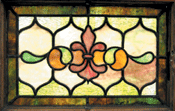
Even the 1800's Victorian pantry was not without it's uniqueness. This
adorable window (13" x 17") was salvaged just in the nick of time. The center is
decorated with the popular fleur-de-les motif. Many windows were stationary, but
this one was hinged to the left with a knob at the right for opening it.

This stunning Victorian example was attached to a large front parlor, single
pane picture window. The colors are outstanding, as is the central shield,
topped with a small fleur-de-les and a center medallion.
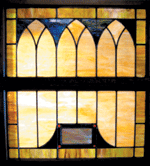
A stained glass window glows with color, brightening a master bath
(inset)
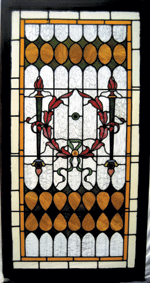
This large (32" x 62") window
was removed from the front hall
of an 1890s
Chicopee, Mass., home near a Victorian staircase. The pattern is exceptionally
charming with a center pink wreath flanked
by large candles.
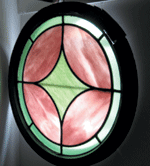
This rare 1700s round leaded glass window was salvaged from a
dilapidated
ocean-front home in New Port, R.I. It was purchased from an on-site estate
sale.
(Photo: ADYS Mortgage, Inc., www.adysmortgage.com
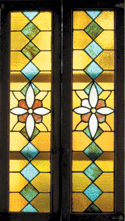
This set of windows formerly
graced the front doors of a late 1800's
Victorian home. Currently, they hang in a glass-filled room, creating
a colorful space. |